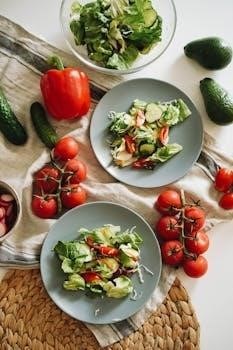7-Day Vegetarian Keto Meal Plan Overview
This 7-day vegetarian keto meal plan provides a structured approach to a low-carb, high-fat diet, using plant-based recipes. It aims to achieve ketosis while offering varied and delicious meals for healthy, sustainable eating, and focusing on balanced macros for weight loss and overall well-being.
Embarking on a vegetarian ketogenic diet combines the principles of a high-fat, low-carbohydrate approach with the exclusion of meat, making it a unique nutritional path. This diet focuses on consuming a majority of calories from fats, a moderate amount from protein, and very few from carbohydrates, aiming to shift the body into a state of ketosis. Achieving this state requires meticulous planning, especially when restricting meat, as it necessitates creative and strategic use of plant-based sources for fats and protein. A well-structured vegetarian keto plan ensures adequate nutrition while adhering to the low-carb requirements, often relying on foods like avocados, nuts, seeds, and certain dairy products, if included. This dietary approach can present challenges in maintaining variety and nutrient balance, but with proper planning, it can be a sustainable and effective way to manage weight and improve health. It’s essential to be mindful of carbohydrate sources and carefully select ingredients to meet the strict macro requirements of the keto diet, all while staying true to vegetarian principles. Many resources offer recipes and guidance to navigate this dietary approach successfully.
Macro Breakdown for Vegetarian Keto
The macronutrient breakdown for a vegetarian keto diet typically prioritizes a high percentage of calories from fats, a moderate portion from proteins, and a very small fraction from carbohydrates. Generally, this translates to roughly 70-80% of daily calories coming from healthy fats, such as those found in avocados, nuts, seeds, and olive oil. Protein intake usually constitutes about 15-25% of total calories, with sources like tofu, tempeh, eggs (if included), cheese, and plant-based protein powders. Carbohydrates are significantly restricted, typically making up only 5-10% of the daily calorie intake, with net carbs being the focus. This means focusing on non-starchy vegetables and being mindful of hidden sugars in processed foods. It’s crucial to track these macros carefully, especially when starting the diet, to ensure the body enters and maintains a state of ketosis. Individual needs may vary, and it’s advisable to consult a doctor or nutritionist to personalize macro targets based on factors like activity level, age, and health goals. This balance of fats, proteins, and carbs is essential for the success of a vegetarian keto lifestyle.

Sample Meal Plan Structure
This sample meal plan structure provides a template for each day, including breakfast, lunch, and dinner, and often incorporates a snack. The focus is on low-carb, high-fat vegetarian options, ensuring a variety of recipes throughout the week.
Day 1⁚ Example Meals
Day one of this vegetarian keto plan starts with a nutritious and satisfying breakfast option, such as an avocado and spinach smoothie, which blends together healthy fats from avocado with the fiber and nutrients of spinach, creating a smooth, energizing start to the day. This particular breakfast choice is designed to be both filling and keto-friendly. For lunch, consider a keto cauliflower fried rice, a low-carb alternative to traditional fried rice that is packed with vegetables and flavors, providing a hearty and healthy midday meal. The day one dinner option could include zucchini noodles with pesto, offering a light yet fulfilling meal. This meal combines the fiber of zucchini with healthy fats from pesto. To round out the day, snacks like roasted salted almonds, cheese sticks, or olives, provide extra healthy fats and protein to keep hunger at bay. These choices ensure a balanced intake of fats, protein, and low carbs, adhering to the core principles of a vegetarian keto diet, and setting a solid foundation for the rest of the plan.
Breakfast Options
For breakfast on a vegetarian keto plan, variety and nutrient density are key. Options include a chia seed pudding made with almond milk, topped with berries and nuts, offering a mix of fiber, healthy fats, and antioxidants. Another great choice is a keto frittata with baby spinach and tomatoes, providing protein and essential vitamins. Scrambled eggs with spinach and mushrooms cooked in butter is another classic, simple, and effective way to start the day. Keto oatmeal is also a suitable choice, offering a warm, comforting, and low-carb alternative to traditional oatmeal. An avocado and spinach smoothie, packed with healthy fats and fiber, is a quick and easy option for busy mornings. These selections are designed to be both satisfying and compliant with the ketogenic dietary guidelines. These breakfast choices help ensure adequate intake of fats and proteins while keeping carbohydrates at a minimum. Such variety ensures that your mornings are never dull and keep you on track with your dietary goals.

Lunch Options
Vegetarian keto lunch options focus on providing sustained energy and essential nutrients while keeping carb intake low. A chilled avocado soup, blended with vegetable broth and coconut cream, is a refreshing and creamy choice, rich in healthy fats. Kale salad with avocado dressing offers a nutritious mix of greens and fats, ensuring a satisfying and flavorful meal. Keto cauliflower fried rice is a great way to enjoy a familiar dish with a low-carb twist, using cauliflower instead of rice. Another option is grilled paneer cheese served with roasted Brussels sprouts and cauliflower, providing a good source of protein and fiber. Avocado toast with spinach, tomatoes, and hummus is also suitable, offering a balanced combination of healthy fats, protein, and vitamins. These lunch options ensure that you remain full and energized throughout the afternoon while adhering to the ketogenic diet’s macronutrient ratios. The variety in these meals also ensures you get a good range of nutrients and flavors each day, making the dietary journey enjoyable and sustainable.
Dinner Options
Vegetarian keto dinner options prioritize satiety and flavor while adhering to low-carb guidelines. Vegan chickpea curry provides a hearty and flavorful meal, packed with plant-based protein and healthy fats. Stuffed peppers with quinoa and marinara sauce offer a nutritious and satisfying dish, combining fiber and rich flavors. Zucchini noodles with pesto are a light yet fulfilling option, perfect for a lighter evening meal, using a low-carb noodle alternative. Keto pizza topped with olives, tomatoes, and rocket is a fun and customizable option, allowing for a variety of low-carb toppings. Saag paneer, a classic Indian dish, can be adapted to be keto-friendly, providing both flavor and essential nutrients. These dinner options ensure that you end your day with a delicious and satisfying meal while maintaining ketosis. The variety of flavors and textures will keep you engaged in your meal plan. Each option is designed to provide adequate nutrients while keeping carbohydrate intake to a minimum, supporting your weight loss goals and overall health. These dinners are also designed to be easy to prepare, fitting into busy schedules.

Key Vegetarian Keto Recipes
This section features essential vegetarian keto recipes, including dishes like keto-friendly saag paneer, stuffed peppers, and zucchini noodles with pesto. These recipes will help you stay on track and enjoy a variety of flavors.
Keto-Friendly Vegetarian Dishes
Embarking on a vegetarian keto diet opens a world of delicious and nutritious possibilities. This section highlights key keto-friendly vegetarian dishes, designed to be both satisfying and compliant with the diet’s requirements. Expect to find recipes that ingeniously combine low-carb vegetables with high-fat ingredients, ensuring you stay within your macro targets while enjoying diverse flavors. From savory options like keto cauliflower fried rice, a great alternative to traditional high-carb versions, to comforting dishes such as vegan chickpea curry, showcasing how plant-based proteins can be incorporated effectively. Explore creative meals like stuffed peppers with quinoa and marinara sauce, which provide a delightful texture and taste profile. Also, consider the versatility of dishes such as keto frittatas with baby spinach and tomatoes, an ideal way to pack in nutrients and healthy fats. These dishes not only cater to the vegetarian aspect but also strictly adhere to the keto principles, ensuring your body enters and remains in ketosis. Our collection emphasizes both variety and ease of preparation, making your vegetarian keto journey smooth and enjoyable.

Snack Ideas
Maintaining a vegetarian keto diet requires careful planning, especially when it comes to snacks. This section is dedicated to providing you with a variety of delicious and convenient keto-friendly vegetarian snack ideas. These options are designed to keep you feeling full and satisfied between meals, without compromising your ketogenic goals. Consider incorporating cheese sticks, which are a simple and readily available source of fat and protein. Olives are another excellent choice, offering healthy fats and a burst of flavor. Pickles, with their low-carb content and tangy taste, can also be a great way to curb cravings. For those with a sweet tooth, keto fat bombs are a wonderful option, providing a concentrated dose of healthy fats to keep you energized. Roasted salted almonds and other nuts are also perfect for a quick and easy snack that’s packed with nutrients. You might also explore other options such as celery sticks with goat cheese, or even a small portion of a keto-friendly banana bread. These snack ideas are not only convenient but also ensure that you are sticking to your macro goals while enjoying a wide range of flavors and textures.
Tips for Success
Embarking on a vegetarian keto diet requires careful planning and attention to detail. To maximize your chances of success, it’s crucial to plan your meals in advance, ensuring you have all the necessary ingredients on hand. Focusing on healthy fats is essential, as they will be the primary source of your energy. Pay close attention to your carbohydrate intake, carefully monitoring your net carbs to stay within the limits of the ketogenic diet. Remember to consult with a doctor or nutritionist to determine the best macro ratios for your specific body needs. Incorporating a variety of plant-based foods will help ensure you are getting all the essential nutrients. It’s also helpful to explore different recipes to prevent boredom and keep you excited about your meals. Experimenting with keto-friendly and nutritious plant-based vegetarian foods can make the transition easier and more enjoyable. Staying mindful of your choices and adjusting your approach as needed will help you navigate this diet successfully. Tracking your progress and making small adjustments along the way will also keep you motivated and on the right track.
